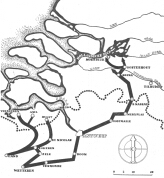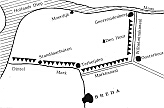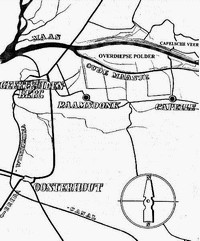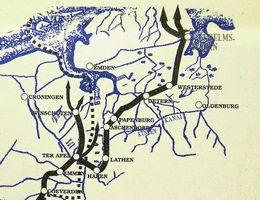HOLLAND
Entering Dutch territory at Noord Bosch en Heide on the 4th of October.

click on map to enlarge
The Regiment began a period of very heavy fighting on ground most unfavourable for armoured warfare. The Germans put up a determined fight, reasing how important the access to the port of Antwerp would be for the future activity of the Allied army on German territory itself. Rain and mud - the soldier's greatest enemy - arrived.
On the 5th Oct the attack of the 1st Armd Div. in the direction of Baarle-Nassau began, it was aimed at the centre of the enemy's defence in the triangle Turnhout-Tilburg-Breda.
The Regiment, was to attack from point south east of Veldbraak on the axis Oordeel-Heikant, and to take a northern part of Alphen from the east. The Regiment advanced to the attack in the formation of two up in front with the 2nd and 3rd Squadron and the squadron of Dragoons on tanks of the first Squadron in the second line. The Recce Troop secured the action from east. The tanks had to deal with heavy ground and mine fields which they bypassed from the east and entered Terover-Hondseind.
After leaving there the 3rd Squadron broke through into artillery positions of the enemy. The Regiment was under heavy anti-tank fire. The 3rd Squadron destroyed four 155 mm guns and succesfully defended conquered territory.
3 anti-tank guns S. P. were destroyed. Almost the whole Bn of 51 Flieger Regt. surrendered. The Regiment was ordered to halt and organise defence positions.
The stay lasted till 26 Oct. The tanks were in positions, the crews built big shelters under tanks. Lt. BNINSKI Roman became commander of the 2nd Squadron.
On the 27 Oct an action began which was to lead to the liquidation of the enemy south of the river Maas. Second in Command commanding the Regiment. At 07.30 a.m. the Regiment advanced to the attack in support of the 8 Rifle Bn. at Alphen - Oosterwijk - Gilze. At 14.00 p.m. the 3rd squadron together with the 10th Dragoons entered Gilze.
In the evening the Regiment in battle group, with the 10th Dragoons, departed in order to seize Rijen and the crossing on the Wilhelmina Canal in the area of Oosterhout. At 22.00 hrs. the 2nd Squadron as advanced guard, became involved in heavy fighting at Rijen.
On the 28 Oct at 02.00 hrs. orders were changed and the formation was to attack the town of Breda from the east. On the march for Dorst, with the 3rd Squadron as an advance guard the Regiment silenced very strong anti-tank fire, at the moment when many tanks came to a stop in the muddy ground. Only at 19.30 hrs. was change of route given and the Regiment entered Dorst.
At 22.00 hrs. a night attack was made in order to seize the road junction east of Breda. The 1st Squadron was in the front line, and with the tanks was the squadron of Dragoons. The enemy put up a desperate resistance taking advantage of the night and the woods near the road.
The 2nd Squadron attacked from the south. Both squadrons joined at the given destination point at 03.00. hrs. The enemy's artillery fire was very strong. Supplies were made difficult by the presence of great numbers of enemy left in the rear.
On the 29 Oct at dawn the enemy counter attacked for Dorst. The 3rd Squadron intervened retaking Dorst. On the 30th Oct. Breda was taken.
The Regiment on security duty was relieved by a squadron of the Canadian Recce Regt and proceeded at 16.00 to the town of Breda, placing outposts from the north at Teteringen, where on the 31 Oct. the 1st Squadron arrived.
Dutch military organisations were helpful on security service.
November 3rd was a day of heavy fighting for the crossing of the Mark-Canal. The 3rd Squadron gave fire support to the 9th Rifle Bn. The 2nd Squadron gave support to the Highland Bn.
The 1st Squadron was included in the battle group of the 10th Dragoons who took the town of Den Hout at 16.00 hrs.
On the 4 Nov the Regiment without the 1st and 3rd Squadrons, took Terheijden, included after that in the battle formation of 9 Rifle Bn took Wagenberg.
The 3rd Squadron with the Highland Bn fought for Heikant. At 16.30 hrs. the 1st Squadron rejoined the unit and secured the western flank.
On the 5th and 6th Nov stayed at Den Hout, next day the Regiment proceeded to Teteringen. At 20.15 hrs. order was given by telephone to be at the disposal of the 3rd Rifle Brigade.

click on map to enlarge Mark-Dintel Line
On the 8 Nov at 10.00 hrs. the Regiment, on the causeway at Teteringen received the orders to take the bridge head of Moerdijk. Preparatory work, i.e. the making of breaches in the anti-tank entrenchments was to be done, by the 10th Mtd. Rifle Regt.
The Regiment had the support of the whole divisional artillery plus rocket guns, a Coy. of 9 Rifle Bn and a section of sappers.
The enemy had at his disposal some 3 Bns., SP guns and a great quantity of artillery of bigger calibre on the other side of the river Maas. The O.C. Regt. made contact with O.C. Mounted Rifle Regt. who left after the making of the breaches.
Out of three apparently possible roads, the middle and the right one were ready for use. The Highland Bn was to act along the river Maas from the east. 8 Rifle Bn was to clear newly won territory. The C.O.'s of squadrons dispatched at 11-15 hrs. It rained and no aircraft could be used. The order had to be carried out irrespective of losses. The ground was artificially flooded. Moving in column was possible only on three roads which were above water level. It was impossible to turn the tanks round.
Destroyed tanks had to be pushed aside onto the water in order to proceed wth the atack. At 12.10 hrs. the squadrons set out, the 1st Squadron moving on the right, the 3rd Squadron moving in the middle, the 2nd Squadron, Rgt. H.Q. and recce troop behind the 3rd Squadron.
The artillery fire reached unparalled intensity. The opening in the obstruction being too small, the 3rd Squadron had to enlarge it. 3 tanks after passing the obstruction were damaged by mines and arty fire.
Removing them was made very difficult because of the mines and artillery and MG fire. In view of these difficulties the 1st Squadron, moving on the narrowest road was ordered, after achieving its objective to proceed parallel with the river Maas (distance 700 yards), to drive righ into the middle of the enemy formations and to take Moerdijk. The 2nd Squadron was to move behind the 1st Squadron.
At 14.45 hrs. the 1st Squadron was in the town. Very heavy enemy artillery fire did not permit the infantry to reach the tanks in order to clear the locality. The port district was strongly defended by the enemy with some 6 SP guns and entrenched infantry.
At dusk our infantry arrived. The 2nd Squadron was on the dike. The recce troop joined the 1st Squadron. The tanks were short of ammunition, which could not be brough up, because of road demolitions.
On 9 Nov at 08.00 hrs. the 1st Squadron, with the 8 Rifle Bn. with fire support from the 2nd Squadron, cleared up the remaining part of the town. The road on which the attack advanced was completely under water.
At 11.00 hrs. the Regt was relieved by the 1st Armd. Regt. In cooperation with the infantry, 370 prisoners were taken at the time of the action in Moerdijk, among them 10 officers, one SP gun was captured and 6 SP guns were destroyed.
Our losses: 3 tanks damaged and 4 men wounded.

click on map to enlarge
From the 9 Nov to the 21 Dec the Regiment remained at Teteringen on protection duty on the river Maas in the area of Raamsdonksveer, Made and Zevenbergsche Hoek. The Regt. was made up to strength and the Sherman tank with 75 mms guns exchanged for tanks with 76 mm guns.
In connection with the Rundstedt offensive in the Ardennes and the concentration of detachments of Parachutists in the northern part of Holland, the Regiment was put in a state of readiness.
The 1st Squadron left for Oosterhout in support of 47th Commandos. The 2nd Squadron went to Terheijden, as support for the Manitoba Dragoons.
3rd Jan 1945 the Regiment without the 1st and 2nd Squadrons moved to Dongen. 15 Febr the appointment of Second in Command of the Regt. was taken over by Capt. STARZYNSKI and Lt. FRIEDRICH became O.C. 1st Squadron. Capt. LOS Tadeusz was appointed as O.C. HQ Sq.
From 8 Jan 1945 to the 7th April 1945 the whole Regiment remained at Oosterhout, with the squadrons on duty on the river Maas.
GERMANY

click on map to enlarge
On 7th of April 1945, the Regiment departed from Oosterhout and after a 160 miles march came to the area of Goor and crossing the Maas river at Gennep entered Germany. Through Goch and Calcar it reached the Rhine which was crossed at Rees on 8 April 1945 at 15.00 hrs.
On 10th of April the Regt. reached Wielen.
The march route was to the north along the Dutch-German border.
On 12 April 1945 without any contact with the enemy, the Regt. halted in the woods of Emmen then arrived the exciting news about the liberation by 2nd Armd Regt. of the camp at Oberlangen of the Women serving with the Polish Underground Army. Numerous soldiers from the Regiment found there during that great day their relations and acquaintances.
On 14 April 1945 the 3rd Squadron was sent to support the 9 Rifle Bn in seizing the bridgehead on the Ems river at Haren. The Regiment advancing on the same route reached the Neu Ahlen woods. Where the forward elements were stopped by strong enemy opposition on the Küsten Kanal. On the same water obstacle further to the east the 4th Cdn. Armd. Div. was stopped.
From 15 April to 19 April there was constant patrolling by the recce troop and 2nd Squadron and during the same time 9th Rifle Bn with the 3rd Squadron tried to force the Canal.
On 20 April 1945 at 11.30 hrs. the Regiment crossed the canal and struck through Neu Herbrum at Aschendorf from the East. From the south the 1st Armd Regt. was attacking the same town. The 1st Squadron as the advance guard was involved in the fierce fighting with the enemy in the eastern part of the town. The 2nd Squadron with the recce troop and one infantry company attacking on the right wing of the 1st Squadron crossed the canal near Papenburg.
At dusk, along the road mined with the bombs ready to be exploded the 2nd Squadron with the recce troop entered the first outskirts of Papenburg. Here they had to stop because of the craters in the road.
The 3rd Squadron on reconnaissance duty for the Brigade reached the Eastern part of Papenburg at dusk.
On 21 April 1945 at 11.30 hrs. the Regiment took the northern part of Papenburg. The 1st Armd Regt. passed our Regiment, advancing to the north. The Regiment with two companies of 9th Rifle Bn has the task of striking at Kolinghorst from the South. The leading 3rd Squadron with the recce troop met strong enemy resistance in the marshy and overgrown terrain which kept the tanks to the roads which were few and narrow and the battle went on till dusk.
The prisoners taken were German Marines. They were young, determined, and ready to fight to the last and had at their disposal a great quantity of 75 mm anti-tank guns and anti-tank grenade throwers (Panzerfaust). There was also harassing fire from 88 mm anti-aircraft guns. Many tanks were bogged down on the ground and even on the roads. Their recovery took a long time and the efforts of the regimental L.A.D. were herculean.
On 22 April 1945 in a further move hampered by heavily damaged roads and even more boggy terrain, the Regiment changed the direction of the attack.
Exploiting the success of the 1st Armd Regt. in Ihrhove, the Regiment marched round from the west and attacked the defences of Kollinghorst from behind. The enemy was completely surprised and at 15.00 hrs. the 1st Squadron destroying several anti-tank guns entered the village. There were many prisoners. At 17.00 hrs. the 2nd Squadron with one company of 9th Rifle Bn was sent out to seize bridgeheads at Rhandermoor.
The crossings were strongly defended, and the majority of tanks became bogged down on
the muddy road. Only on the next day when all the tanks had been recovered did the Squadron reach Brainermoor and then Schattenburg. The 3rd Squadron with the recce troop reconnoitred the crossings on the canals to the East.
The Regiment then moved to Bakemoor. From there half squadrons were sent in succession to support the 10th Regt. Dragoons in the crossing of the channels of the Leda river the last major obstacle before Emden and Wilhelshaven.
On 26 April 1945 2/Lt. SZCZEPANOWSKI Jerzy leader of the 3rd troop of the 1st Squadron was killed as the last soldier of 24th Lancers to fall in the war of 1939-1945.
On 3 May 1945 the Regiment in the group of 3rd Mtd. Bde moved in to action on Wilhelmshaven. At Bokel the Regiment came to halt and the "cease fire" was given 08.00 hrs. on 4 May.
5 May 1945 was the end of action against Germany. The news was received by the soldiers of the Regiment without great emotion. Except for the pride of dute well done, the end of the fight did not mean to the Regiment the attaining of its aims.
After one day's halt at Westerloy the Regiment moved to Zetel. In the first phase arose such problems as the control of surrendering German soldiers, maintaining order amongst the civilian population, securing the war equipment and the most difficult one the security and care of the
displaced persons.
On 16 May 1945 Major RAKOWSKI returned to the Regiment and took up the duty of second in command and Capt. STARZYNSKI returned to the 1st squadron as its commander.
17 May 1945 the Regiment said farewell to the G.O.C. Gen. Stanisław MACZEK under whom the Regiment fought during the whole war from the Polish campaign until the end of the campaign in Germany.
On 11 May 1945 the new C.O. C. Gen. RUDNICKI Klemens reviewed the Regiment. On 21 May 1945 the Regiment moved to the area of Holte (Oldenburg) to the new area of occupation of 1st Armd. Div. attached to 30 Brit. Corps.
The 24th Lancers in its part of the common fight for freedom of Europe paid the price of 14 officers and 60 other ranks killed and 18 officers and 129 other ranks wounded.
With 48 Sherman tanks and 12 Stuart tanks lost in action between Caen and Wilhelshaven and inflicted the following certain losses to the enemy:
- 22 August 1944 -
1 Jagd Panther
4 Panther tanks
8 tanks MK- 4
6 anti-tank guns 88 mm
5 anti-tank guns 50 mm
About 20 mortars
About 2000 prisoners
- 29 August - 22 September 1944 -
4 guns 220 mm
8 anti-tanks guns 88 mm
12 anti-tank guns 75 mm
26 guns 20 mm
About 10 mortars
About 1200 prisoners
- 22 September - 5 October 1944 -
12 guns 155 mm
3 SP guns
3 anti-tank guns 75 mm
6 anti-tank guns 37 mm
2 anti-aircraft guns
2 Armd tracks
2 Armd cars
2 Armd "Wagens"
About 10 mortars
About 300 prisoners
- 27 October - 8 November 1944 -
10 SP guns
6 "PanzerWagens"
About 450 prisoners
- 7 April - 8 May 1945 -
27 anti-tank guns 75 mm
over 1500 prisoners
|